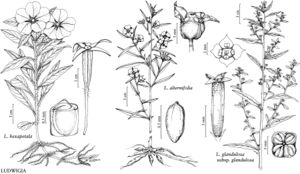Ludwigia glandulosa subsp. glandulosa
Stems usually reddish green, (20–) 40–80 (–100) cm. Leaves: petiole 0.1–1.5 cm, blade elliptic to very narrowly elliptic, those on main axis 3.2–12 × 0.4–2.1 cm, those on branches 1–4.5 × 0.3–1 cm. Inflorescences: bracteoles attached at base of ovary or to 2 mm distal to base, rarely on pedicel, 0.5–1 × 0.2–0.4 mm. Flowers: sepals 1.3–2.3 × 1.2–1.7 mm, apex acuminate; nectary disc glabrous; style 0.3–0.5 mm, stigma 0.3–0.5 mm diam. Capsules subterete, (4–) 5–8 (–9) × 1.6–2 (–3) mm, pedicel 0–0.4 (–0.5) mm. Seeds 0.5–0.7 × 0.3–0.4 mm, surface cells elongate parallel to seed length.
Phenology: Flowering Jun–Sep.
Habitat: Roadside ditches, marshes, pond borders, wet meadows, swales, alluvial floodplains, peaty bogs, moist pinelands, swampy woodlands, waste ground.
Elevation: 0–300 m.
Distribution
Ala., Ark., Fla., Ga., Ill., Ind., Ky., La., Md., Miss., Mo., N.C., Okla., S.C., Tenn., Tex., Va.
Discussion
The distribution of subsp. glandulosa is relatively continuous along the Atlantic and Gulf coastal plains, extending inland to Tennessee, extreme western Kentucky, extreme southern Indiana, Illinois, and Missouri, to southeastern Oklahoma and eastern Texas, with disjunct populations in Maryland and in north-central Missouri. In Florida, it occurs only in the panhandle region.
Selected References
None.
